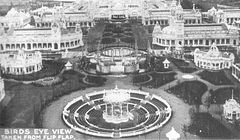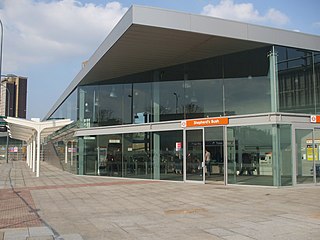
White City is a district of London, England, in the northern part of Shepherd's Bush in the London Borough of Hammersmith and Fulham, 5 miles (8 km) west-northwest of Charing Cross. White City is home to Television Centre, White City Place, Westfield London and Loftus Road, the home stadium of Queens Park Rangers F.C. The district got its name from the white marble cladding used on buildings during several exhibitions when the area was first developed, between 1908 and 1914.

The London Borough of Hammersmith and Fulham is a London borough in West London and which also forms part of Inner London. The borough was formed in 1965 from the merger of the former Metropolitan Boroughs of Hammersmith and Fulham. The borough borders Brent to the north, the Royal Borough of Kensington and Chelsea to the east, Wandsworth to the south, Richmond upon Thames to the south west, and Hounslow and Ealing to the west.
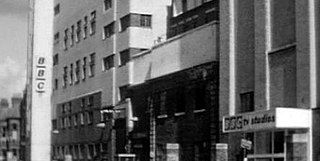
Lime Grove Studios was a film, and later television, studio complex in Shepherd's Bush, West London, England.

Shepherd's Bush is a suburb of West London, England, within the London Borough of Hammersmith and Fulham 4.9 miles (7.9 km) west of Charing Cross, and identified as a major metropolitan centre in the London Plan.

Shepherd's Bush is an area of west London, England, which has been served by a number of London Underground and commuter rail stations over the past 150 years, many of which have had similar names. The names Shepherd's Bush, Wood Lane and White City have each been used by several separate stations around the Shepherd's Bush district, following a number of station renamings and closures.

White City Place is the name given to the collection of buildings formerly known as BBC Media Village. White City Place is a collection of six buildings occupying a 17-acre site off Wood Lane, White City in West London, bordered by South Africa Road, Dorando Close and the A40 Westway. The site is a short distance along Wood Lane from BBC Television Centre. All formerly properties of the BBC, only two buildings – Broadcast Centre and the Lighthouse – are currently occupied by BBC staff.
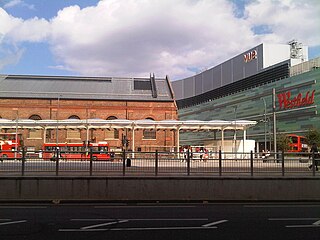
Wood Lane is a street in London. It runs north from Shepherd's Bush, under the Westway (A40) past Wormwood Scrubs where it meets Scrubs Lane. The road is wholly in the London Borough of Hammersmith and Fulham. It is probably best known as the former home of the BBC Television Centre, also BBC White City and formerly BBC Woodlands the offices of BBC Worldwide.
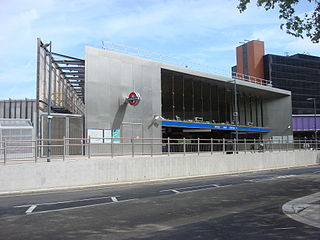
Wood Lane is a London Underground station in the White City area of west London, United Kingdom. It is on the Circle and Hammersmith & City lines, between Latimer Road and Shepherd's Bush Market stations, in Travelcard Zone 2.

Wood Lane is a former station on the London Underground located in Shepherd's Bush, west London. It was latterly served by the Central line and from 1908 to 1920 was the western terminus of the Central line's precursor, the Central London Railway (CLR).
Wood Lane was a station on the London Underground that was located in Shepherd's Bush, west London. It was opened in 1908 on the Hammersmith branch of the Metropolitan Railway, on the viaduct adjacent to the bridge over Wood Lane and close to a station of the same name but on the Central London Railway.

Shepherd's Bush is a London Underground station in the district of Shepherd's Bush in the London Borough of Hammersmith and Fulham. The station is on the Central line, between White City and Holland Park stations, and it lies in Travelcard Zone 2.
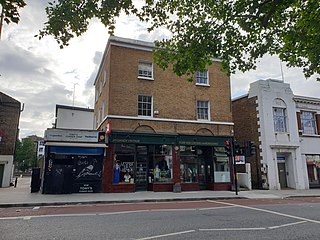
Denmark Hill is an area and road in Camberwell, in the London Borough of Southwark, London, England. It is a sub-section of the western flank of the Norwood Ridge, centred on the long, curved Ruskin Park slope of the ridge. The road is part of the A215 which north of its main foot, Camberwell Green, becomes Camberwell Road and south of Red Post Hill becomes named Herne Hill, another district.

Westfield London is a large shopping centre in White City, west London, England, developed by the Westfield Group at a cost of £1.6bn, on a brownfield site formerly the home of the 1908 Franco-British Exhibition. The site is bounded by the West Cross Route (A3220), the Westway (A40) and Wood Lane (A219). It opened on 30 October 2008 and became the largest covered shopping development in the capital; originally a retail floor area of 1,600,000 sq ft (150,000 m2), further investment and expansion led to it becoming the largest shopping centre in the UK and Europe by March 2018, an area of 2,600,000 sq ft (240,000 m2).

John Belcher was an English architect, and president of the Royal Institute of British Architects.
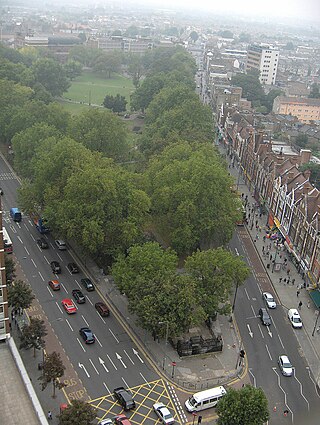
Shepherd's Bush is a neighbourhood in the London Borough of Hammersmith and Fulham centred on Shepherd's Bush Green. Originally a pasture for shepherds on their way to Smithfield market, it was largely developed in the late nineteenth and early twentieth centuries. In 1844 the West London Railway officially opened, followed in 1864 by the Metropolitan Railway who built the original Shepherd's Bush station, opening up the area to residential development. Businesses soon followed, and in 1903 the west side of Shepherd's Bush Green became the home of the Shepherd's Bush Empire, a music hall whose early performers included Charlie Chaplin.
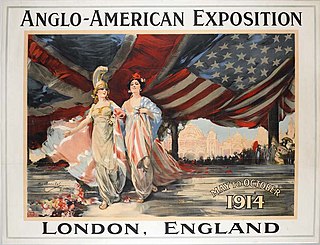
The Anglo-American Exposition of 1914 was one of the last exhibitions held in Shepherd's Bush, London, in the exhibition space known as the Great White City, and later simply as White City. The exhibition site is now occupied by the BBC White City centre and the Westfield London shopping centre, one of the largest in Britain.

The Latin-British Exhibition of 1912 was the fifth in the series of the White City Exhibitions, after previous exhibitions such as the first Franco-British Exhibition of 1908, and one of the last exhibitions held in Shepherd's Bush, London, in the exhibition space known as the Great White City, and later simply as White City. The exhibition site is now occupied by the BBC White City centre and the Westfield London shopping centre, one of the largest in Britain.
The Imperial International Exhibition was a world's fair held in White City, London in 1909. The exhibition was opened by the Duke of Argyll on 20 May 1909 and continued for five months before closing in October.

Hammersmith Park, known to many locals as "The BBC Park" is a public park in the London Borough of Hammersmith and Fulham. It includes a Japanese Garden, a gated children's play area, tennis courts and football pitches run by Play Football. Despite its name, it is located in Shepherd's Bush, not Hammersmith.
White City Depot is one of three traction maintenance depots on the Central line of the London Underground. It is between Shepherd's Bush and White City tube stations. A depot on the site first opened in 1900 by the Central London Railway when the line first went into operation. A new underground depot opened in 2007, as part of the Westfield London shopping centre development. This makes it one of only two depots on the London Underground to be completely underground, the other being Waterloo Underground Depot on the Waterloo and City line.
